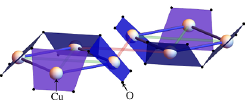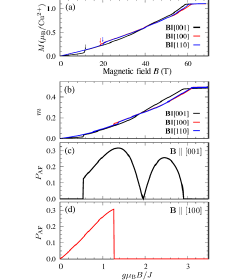Magnetoelectric Behavior in a Chiral Antiferromagnet Ba(TiO)Cu4(PO4)4
Y. Kato, K. Kimura, and A. Miyake
A unique asymmetric magnetic unit, square cupola (see Fig. 1), has been realized in newly synthesized magnetoelectric compounds, A(TiO)Cu4(PO4)4 (A = Ba, Sr) [1]. Spatial asymmetry often activates the asymmetric interactions between localized spins through the relativistic spin-orbit coupling, e.g., the Dzyaloshinskii-Moriya (DM) interaction. The asymmetric interactions lead to intriguing magnetism such as spin-spiral orderings and skyrmion crystals. They have attracted growing interest as an origin of unusual magnetic and electronic properties, such as the magnetoelectric (ME) effect, that is cross-correlations between magnetism and dielectricity. The compound Ba(TiO)Cu4(PO4)4 indeed exhibits a divergent anomaly of the dielectric constant at the Néel temperature (TN = 9.5 K) [2].

Fig. 1. Square cupolas made of Cu4O12 in A(TiO)Cu4(PO4)4 (A = Ba, Sr). The materials have a quasi-two-dimensional structure, composed of an alternating array of upward and downward Cu-cupolas.

Fig. 2. (a) Magnetization curves in the experiment at T = 1.4 K. The arrows indicate the jump-like anomalies. (b) Magnetization curves of the minimal theoretical model obtained by the cluster mean-field approach. (c,d) Magnetic field dependence of the anti-ferroelectric polarization (PAF) for (c) B || [001] and (d) B || [100]. The electric polarization is computed based on the exchange striction mechanism. All the data are taken from Ref. [3].
Here we report the ME properties of this compound by a combined experimental and theoretical study [3]. The magnetization is measured up to the external magnetic field above the saturation at the temperature far below TN (T = 1.4 K) at the International MegaGauss Science Laboratory of the Institute for Solid State Physics at the University of Tokyo. As shown in Fig. 2(a), the magnetization curves exhibit the field-direction dependence with several jump-like anomalies, indicating the importance of the spin-orbit coupling. For understanding the unusual behavior, we construct a minimal theoretical model and study the ground-state and finite-temperature properties of the model. In the compound, because of the loss of inversion symmetry at the centers of bonds connecting the nearest neighbor Cu cations having S = 1/2 degrees of freedom, the DM interaction between the nearest neighbor spins is activated. Taking into account the DM interaction in the model and solving it by the cluster mean-field approximation, we successfully reproduce the entire magnetization curves, as shown in Fig. 2(b), especially, the directional dependence of the saturation fields and the critical fields of the jump-like anomalies. We show that the anomalies are explained by ME phase transitions associated with the noncollinear antiferromagnetic ordering and the antiferroelectric ordering. (See Figs. 2(c) and 2(d).) Moreover, our theory also explains the scaling of the dielectric anomaly at the Néel temperature observed in the experiments.
By further analysis of the model, we elaborate the ME phase diagram of the model by changing the magnetic field and the temperature. The results clarify the crucial role of the in-plane component of the DM vector. We also predict a “hidden” phase and ME response in a nonzero magnetic field, both of which await the experimental confirmation. Our results demonstrate how the asymmetric magnetic units activate the ME responses through the DM interactions arising from the spin-orbit coupling. The present study could inspire motivation on the material design for ME-active materials composed of such asymmetric units.
References
- [1] K. Kimura, M. Sera, and T. Kimura, Inorg. Chem. 55, 1002 (2016).
- [2] K. Kimura, P. Babkevich, M. Sera, M. Toyoda, K. Yamauchi, G. S. Tucker, J. Martius, T. Fennell, P. Manuel, D. D. Khalyavin et al., Nat. Commun. 7, 13039 (2016).
- [3] Y. Kato, K. Kimura, A. Miyake, M. Tokunaga, A. Matsuo, K. Kindo, M. Akaki, M. Hagiwara, M. Sera, T. Kimura, and Y. Motome, Phys. Rev. Lett. 118, 107601 (2017).
